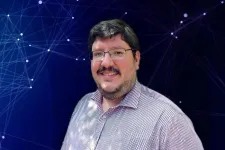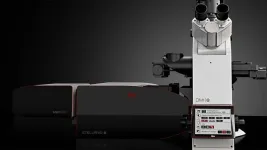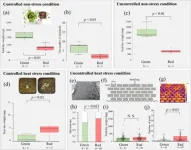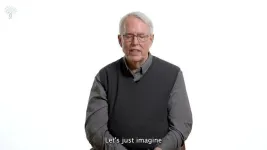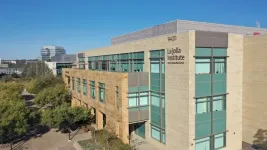(Press-News.org) It’s a familiar story to many of us: In prehistoric times, men were hunters and women were gatherers. Women were not physically capable of hunting because their anatomy was different from men. And because men were hunters, they drove human evolution.
But that story’s not true, according to research by University of Delaware anthropology professor Sarah Lacy, which was recently published in Scientific American and in two papers in the journal American Anthropologist.
Lacy and her colleague Cara Ocobock from the University of Notre Dame examined the division of labor according to sex during the Paleolithic era, approximately 2.5 million to 12,000 years ago. Through a review of current archaeological evidence and literature, they found little evidence to support the idea that roles were assigned specifically to each sex. The team also looked at female physiology and found that women were not only physically capable of being hunters, but that there is little evidence to support that they were not hunting.
Lacy is a biological anthropologist who studies the health of early humans, and Ocobock is a physiologist who makes analogies between modern day and the fossil record. Friends in graduate school, they collaborated after “complaining about a number of papers that had come out that used this default null hypothesis that cavemen had strong gendered division of labor, the males hunt, females gather things. We were like, ‘Why is that the default? We have so much evidence that that's not the case,’” Lacy said.
The researchers found examples of equality for both sexes in ancient tools, diet, art, burials and anatomy.
“People found things in the past and they just automatically gendered them male and didn't acknowledge the fact that everyone we found in the past has these markers, whether in their bones or in stone tools that are being placed in their burials. We can't really tell who made what, right? We can't say, ‘Oh, only males flintknap,’ because there's no signature left on the stone tool that tells us who made it,” Lacy said, referring to the method by which stone tools were made. “But from what evidence we do have, there appears to be almost no sex differences in roles.”
The team also examined the question of whether anatomical and physiological differences between men and women prevented women from hunting. They found that men have an advantage over women in activities requiring speed and power, such as sprinting and throwing, but that women have an advantage over men in activities requiring endurance, such as running. Both sets of activities were essential to hunting in ancient times.
The team highlighted the role of the hormone estrogen, which is more prominent in women than men, as a key component in conferring that advantage. Estrogen can increase fat metabolism, which gives muscles a longer-lasting energy source and can regulate muscle breakdown, preventing muscles from wearing down. Scientists have traced estrogen receptors, proteins that direct the hormone to the right place in the body, back to 600 million years ago.
“When we take a deeper look at the anatomy and the modern physiology and then actually look at the skeletal remains of ancient people, there's no difference in trauma patterns between males and females, because they're doing the same activities,” Lacy said.
During the Paleolithic era, most people lived in small groups. To Lacy, the idea that only part of the group would hunt didn’t make sense.
“You live in such a small society. You have to be really, really flexible,” she said. “Everyone has to be able to pick up any role at any time. It just seems like the obvious thing, but people weren't taking it that way.”
Man the Hunter
The theory of men as hunters and women as gatherers first gained notoriety in 1968, when anthropologists Richard B. Lee and Irven DeVore published Man the Hunter, a collection of scholarly papers presented at a symposium in 1966. The authors made the case that hunting advanced human evolution by adding meat to prehistoric diets, contributing to the growth of bigger brains, compared to our primate cousins. The authors assumed all hunters were male.
Lacy points to that gender bias by previous scholars as a reason why the concept became widely accepted in academia, eventually spreading to popular culture. Television cartoons, feature films, museum exhibits and textbooks reinforced the idea. When female scholars published research to the contrary, their work was largely ignored or devalued.
“There were women who were publishing about this in the ’70s, ’80s and ’90s, but their work kept getting relegated to, ‘Oh, that's a feminist critique or a feminist approach,’” Lacy said. “This was before any of the work on genetics and a lot of the work on physiology and the role of estrogen had come out. We wanted to both lift back up the arguments that they had already made and add to it all the new stuff.”
Lacy said the “man the hunter” theory continues to influence the discipline. While she acknowledges that much more research needs to be done about the lives of prehistoric people — especially women — she hopes her view that labor was divided among both sexes will become the default approach for research in the future.
For 3 million years, males and females both participated in subsistence gathering for their communities, and dependence on meat and hunting was driven by both sexes, Lacy said.
“It's not something that only men did and that therefore male behavior drove evolution,” she said. “What we take as de facto gender roles today are not inherent, do not characterize our ancestors. We were a very egalitarian species for millions of years in many ways.”
END
Challenging prehistoric gender roles: Research finds that women were hunters, too
Team discovered little evidence to support the idea that roles were assigned specifically to each sex
2023-10-20
ELSE PRESS RELEASES FROM THIS DATE:
Felix Parra Diaz elected a fellow of the American Physical Society
2023-10-20
Felix Parra Diaz, the head of the Theory Department at the U.S. Department of Energy’s (DOE) Princeton Plasma Physics Laboratory (PPPL), has been elected a 2023 Fellow of the American Physical Society (APS). This honor recognizes scientists who have helped advance physics by contributing original research, showing how to apply physics to the worlds of science and technology, or exhibiting excellence in physics teaching.
Parra Diaz was cited for “transformational contributions to the theory ...
ESMO Manifesto - Translating scientific evidence into effective public health policy
2023-10-20
ESMO announces Public Policy Manifesto on key issues for oncology to bring to European institutions after 2024 elections.
Studies presented at the ESMO Congress 2023 set new standards of care across a wide range of tumour types.
Madrid, Spain, 20 October 2023 – Evidence is building up that strong political action has the potential to tackle two of our era’s biggest challenges: climate change and the increasing burden of cancer on society. At the opening press conference of the ESMO Congress 2023 taking place 20-24 October in Madrid, Spain, a slew of studies marking meaningful ...
Massachusetts Life Sciences Center awards $4.3 million to MBL to support imaging innovation
2023-10-20
WOODS HOLE, Mass.—The Massachusetts Life Sciences Center (MLSC) has awarded $4.3 million to the Marine Biological Laboratory (MBL) to expand its imaging capabilities to serve the Massachusetts life sciences community.
The grant, which will be used to procure two state-of-the art microscopes capable of increased resolution and advanced technology, such as milling for the reconstruction of samples in 3D, was announced at a press conference on October 18 at the grand opening of a new incubator, the Massachusetts Biomedical Initiatives (MBI).
MBL Director of Research Anne Sylvester ...
Does urbanization trigger plant evolution?
2023-10-20
Urbanization and human activities have transformed a significant proportion of the land on Earth, resulting in the formation of urban environments. These urban environments are man-made habitats that often impose several selective pressures on their inhabitants. A key characteristic of such environments is the presence of impermeable, heat-retaining surfaces created using brick, stone, asphalt, and concrete. Notably, these surfaces form urban heat islands, i.e., regions with elevated surface temperatures. An unexpected result of heat stress ...
Why do some men not produce sperm?
2023-10-20
KANSAS CITY, MO—October 20, 2023—Millions of couples worldwide experience infertility with half of the cases originating in men. For 10% of infertile males, little or no sperm are produced. Now, new research from the Stowers Institute for Medical Research, in collaboration with the Wellcome Centre for Cell Biology at the University of Edinburgh, is shedding light on what may be going wrong in the process of sperm formation, leading to potential theories on possible treatments.
“A ...
Harsh workplace climate is pushing women out of academia
2023-10-20
Women faculty are more likely to leave academia than men faculty throughout all career stages in U.S. universities, University of Colorado Boulder researchers revealed in the most comprehensive analysis of retention in academia to date.
The team published the findings Oct. 20 in the journal “Science Advances.” The researchers found that a harsh workplace climate, which can include harassment and feelings of not belonging, was the most common reason women left academia. This attrition affects not only early-career professionals, ...
Dingoes given ‘almost-human’ status in pre-colonial Australia
2023-10-20
It's said that a dog is a man’s best friend, but the wild dingo is much maligned in Australia. This may not always have been the case though, with new research led by experts at The Australian National University and The University of Western Australia suggesting that dingoes were buried – and even domesticated – by First Nations people prior to European colonisation.
The researchers examined remains at the Curracurrang archaeological site, south of Sydney, where radiocarbon dating of dingo bones revealed the animals were buried alongside humans as far back as 2,000 years ago.
The care taken to bury the animals ...
Soft, living materials made with algae glow under stress
2023-10-20
A team of researchers led by the University of California San Diego has developed soft yet durable materials that glow in response to mechanical stress, such as compression, stretching or twisting. The materials derive their luminescence from single-celled algae known as dinoflagellates.
The work, inspired by the bioluminescent waves observed during red tide events at San Diego’s beaches, was published Oct. 20 in Science Advances.
“An exciting feature of these materials is their inherent simplicity—they need no electronics, no external ...
Army of specialized T cells may trigger asthma attacks in older men
2023-10-20
LA JOLLA, CA—Scientists from La Jolla Institute for Immunology (LJI) and The University of Southampton, UK, have uncovered a group of immune cells that may drive severe asthma. These cells, called cytotoxic CD4+ tissue-resident memory T cells, gather in the lungs and appear to possess the molecular weaponry to cause the most harm in men who developed asthma later in life.
"If you are male and you develop asthma after age 40, there's a high chance this T cell population is in your lungs," says LJI Research Assistant Professor Gregory Seumois, Ph.D., who co-led the study with LJI Professor Pandurangan ...
A cancer survival calculator is being developed using artificial intelligence
2023-10-20
Key Takeaways
A cancer survival calculator prototype developed with machine learning showed that for each of three cancer types tested, more factors than cancer stage significantly influenced patients’ survival.
Preliminary research on the calculator found high accuracy of this individualized survival estimator.
BOSTON (October 20, 2023): Researchers have developed an artificial intelligence (AI)–based tool for estimating a newly diagnosed cancer patient’s chances for surviving long term, according ...
LAST 30 PRESS RELEASES:
Making lighter work of calculating fluid and heat flow
Normalizing blood sugar can halve heart attack risk
Lowering blood sugar cuts heart attack risk in people with prediabetes
Study links genetic variants to risk of blinding eye disease in premature infants
Non-opioid ‘pain sponge’ therapy halts cartilage degeneration and relieves chronic pain
AI can pick up cultural values by mimicking how kids learn
China’s ecological redlines offer fast track to 30 x 30 global conservation goal
Invisible indoor threats: emerging household contaminants and their growing risks to human health
Adding antibody treatment to chemo boosts outcomes for children with rare cancer
Germline pathogenic variants among women without a history of breast cancer
Tanning beds triple melanoma risk, potentially causing broad DNA damage
Unique bond identified as key to viral infection speed
Indoor tanning makes youthful skin much older on a genetic level
Mouse model sheds new light on the causes and potential solutions to human GI problems linked to muscular dystrophy
The Journal of Nuclear Medicine ahead-of-print tip sheet: December 12, 2025
Smarter tools for peering into the microscopic world
Applications open for funding to conduct research in the Kinsey Institute archives
Global measure underestimates the severity of food insecurity
Child survivors of critical illness are missing out on timely follow up care
Risk-based vs annual breast cancer screening / the WISDOM randomized clinical trial
University of Toronto launches Electric Vehicle Innovation Ontario to accelerate advanced EV technologies and build Canada’s innovation advantage
Early relapse predicts poor outcomes in aggressive blood cancer
American College of Lifestyle Medicine applauds two CMS models aligned with lifestyle medicine practice and reimbursement
Clinical trial finds cannabis use not a barrier to quitting nicotine vaping
Supplemental nutrition assistance program policies and food insecurity
Switching immune cells to “night mode” could limit damage after a heart attack, study suggests
URI-based Global RIghts Project report spotlights continued troubling trends in worldwide inhumane treatment
Neutrophils are less aggressive at night, explaining why nighttime heart attacks cause less damage than daytime events
Menopausal hormone therapy may not pose breast cancer risk for women with BRCA mutations
Mobile health tool may improve quality of life for adolescent and young adult breast cancer survivors
[Press-News.org] Challenging prehistoric gender roles: Research finds that women were hunters, tooTeam discovered little evidence to support the idea that roles were assigned specifically to each sex
